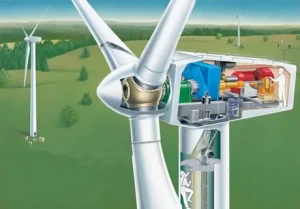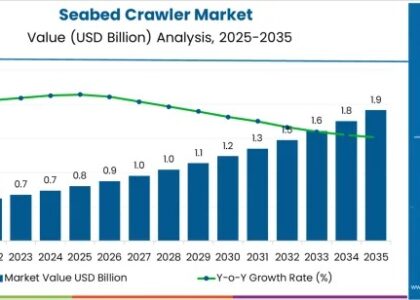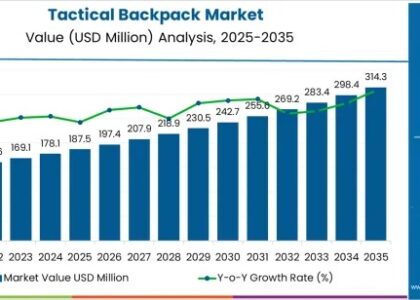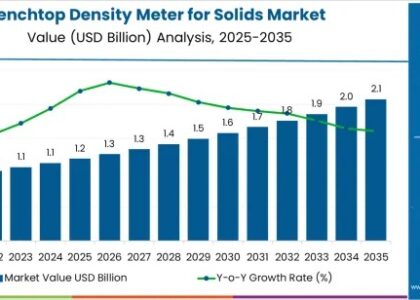
The global sales of wind turbine automation are estimated to be worth USD 19,833.8 million in 2025 and are anticipated to reach a value of USD 52,864.2 million by 2035. This growth reflects a robust CAGR of 10.3% over the forecast period between 2025 and 2035. The upward trend in the market is being driven by a rapid shift toward renewable energy sources, particularly wind power, as nations work toward meeting decarbonization targets. Automation in wind turbine systems enhances reliability, increases energy efficiency, and reduces operational and maintenance costs, making it a strategic component of the modern renewable energy ecosystem. With the increasing complexity and scale of wind farms, particularly offshore installations, automation technologies are becoming vital for real-time monitoring, fault detection, and predictive maintenance.
The surge in demand for sustainable energy sources is accelerating the integration of advanced automation and control systems in wind turbine operations. These systems allow for remote performance monitoring, autonomous adjustment of turbine components, and seamless integration with energy storage and grid systems. Countries across Europe, North America, and parts of Asia are heavily investing in automation technologies to support large-scale deployment of wind energy and minimize dependence on fossil fuels. Simultaneously, as digital transformation takes root in the energy sector, the convergence of IoT, AI, and machine learning with automation systems is unlocking new possibilities for performance optimization and lifetime asset management.
Get Ahead with Our Report: Request Your Sample Now!
https://www.futuremarketinsights.com/reports/sample/rep-gb-198
Key Takeaways
The wind turbine automation market is poised for transformative growth as utilities and independent power producers (IPPs) increasingly prioritize efficiency, reliability, and grid compatibility. Automation plays a central role in ensuring optimal turbine performance under varying environmental conditions by dynamically adjusting rotor speed, pitch, yaw, and generator output. These capabilities are particularly important in offshore wind farms, where human intervention is limited and system uptime is critical. The automation layer not only enhances energy yield but also improves asset longevity by proactively identifying mechanical and electrical anomalies before they escalate into costly failures.
In addition to technical improvements, automation enables streamlined asset management and centralized control of large turbine fleets through SCADA (Supervisory Control and Data Acquisition) systems and remote diagnostic tools. This ensures that operators can reduce manual inspections, plan maintenance windows effectively, and ensure compliance with regulatory requirements. As the wind energy sector matures, scalability and intelligent operation are becoming competitive differentiators for project developers and equipment manufacturers alike.
Emerging Trends in the Global Market
One of the most impactful trends in the wind turbine automation market is the integration of artificial intelligence and machine learning to create predictive analytics platforms. These platforms analyze turbine performance data in real time, enabling automatic tuning of control parameters to maximize output and minimize wear. Digital twin technology is also gaining popularity, where a virtual replica of a turbine is maintained to simulate, predict, and improve actual turbine performance. This allows operators to plan maintenance activities precisely and reduce downtime.
Another significant trend is the increasing adoption of edge computing and advanced sensor networks within turbine nacelles. These systems process data locally to enable faster decision-making and reduce latency associated with cloud-based monitoring. Moreover, cybersecurity is emerging as a key area of investment, as wind turbines become increasingly connected to digital grids and susceptible to cyber threats. Companies are deploying robust encryption, firewalls, and intrusion detection systems to safeguard critical infrastructure.
Significant Developments in the Global Sector: Trends and Opportunities in the Market
Across the global renewable energy sector, automation in wind turbines is being recognized as a crucial enabler of both operational excellence and economic viability. As governments implement favorable policies and feed-in tariffs for wind energy generation, there is an increasing need for robust automation solutions that ensure cost-effective scalability and performance. Moreover, with land-based wind projects reaching saturation in many regions, the focus is shifting toward offshore wind farms, which require higher levels of automation due to accessibility challenges and more demanding operating conditions.
The growth of hybrid renewable energy systems, combining wind with solar or battery storage, also presents an opportunity for integrated automation solutions that coordinate energy production and grid dispatch from multiple sources. Wind turbine automation systems that offer interoperability with storage systems and smart grids are gaining traction. Vendors are innovating to create modular, open-architecture solutions that facilitate seamless upgrades and integration with future digital tools, offering customers long-term value and reduced lifecycle costs.
Recent Developments in the Market
Recent developments in the wind turbine automation market include the launch of AI-enhanced SCADA systems, real-time load balancing algorithms, and automated pitch and yaw control systems. Global players are introducing modular automation platforms that enable turbine customization based on location, turbine size, and weather variability. Technological innovations such as vibration sensors, temperature monitoring tools, and cloud-based analytics dashboards are being rolled out to support condition-based maintenance strategies.
There has also been a noticeable increase in collaborative projects between wind turbine manufacturers and software companies, aiming to develop integrated platforms that blend hardware automation with advanced analytics. Countries such as Denmark, Germany, China, and the United States are leading the way with new offshore wind projects that embed automation into every stage of the turbine lifecycle. The increasing standardization and digitalization of wind farm components are further boosting the deployment of plug-and-play automation systems, which accelerate construction timelines and reduce commissioning errors.
Thorough Market Evaluation: Full Report
https://www.futuremarketinsights.com/reports/global-wind-turbine-automation-market
Competition Outlook
The wind turbine automation market is characterized by a highly competitive environment, with global industrial automation giants and specialized renewable energy technology providers vying for market share. Leading firms are focusing on innovation, energy yield optimization, and strategic partnerships with wind farm developers and turbine OEMs. The emphasis is on offering turnkey automation solutions that incorporate control systems, data analytics, condition monitoring, and cybersecurity features into a unified platform.
Key players
Key players in the market include Siemens AG, General Electric Company, ABB Ltd., Schneider Electric SE, Mitsubishi Electric Corporation, Rockwell Automation Inc., Honeywell International Inc., Emerson Electric Co., Yokogawa Electric Corporation, and Nordex SE. These companies are leveraging their expertise in industrial automation and digital transformation to design scalable and intelligent wind turbine control systems. Their solutions are helping wind farm operators meet regulatory targets, enhance operational efficiency, and reduce overall project costs.
Key Segmentations
The wind turbine automation market can be segmented by component, turbine type, automation technology, application, and region. By component, the segments include sensors, controllers, human-machine interfaces (HMIs), and software solutions, with controllers and SCADA systems being the most widely adopted. By turbine type, the market is divided into onshore and offshore, with offshore gaining momentum due to large-scale government investments. By automation technology, the market includes SCADA, condition monitoring systems, remote diagnostics, and predictive maintenance platforms, all of which are seeing strong growth. Application segments include utility-scale wind farms, commercial installations, and research and development centers, with utility-scale deployments driving the majority of automation demand.
About Future Market Insights (FMI)
Future Market Insights, Inc. (ESOMAR certified, recipient of the Stevie Award, and a member of the Greater New York Chamber of Commerce) offers profound insights into the driving factors that are boosting demand in the market. FMI stands as the leading global provider of market intelligence, advisory services, consulting, and events for the Packaging, Food and Beverage, Consumer Technology, Healthcare, Industrial, and Chemicals markets. With a vast team of 400 analysts worldwide, FMI provides global, regional, and local expertise on diverse domains and industry trends across more than 110 countries.
Contact Us:
Future Market Insights Inc.
Christiana Corporate, 200 Continental Drive,
Suite 401, Newark, Delaware – 19713, USA
T: +1-845-579-5705
For Sales Enquiries: sales@futuremarketinsights.com
Website: https://www.futuremarketinsights.com
LinkedIn| Twitter| Blogs | YouTube





